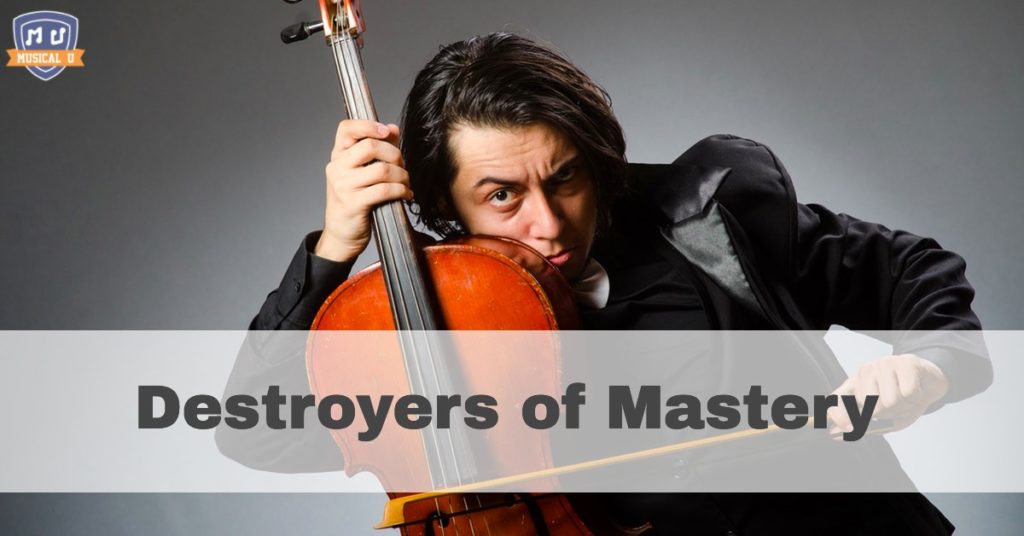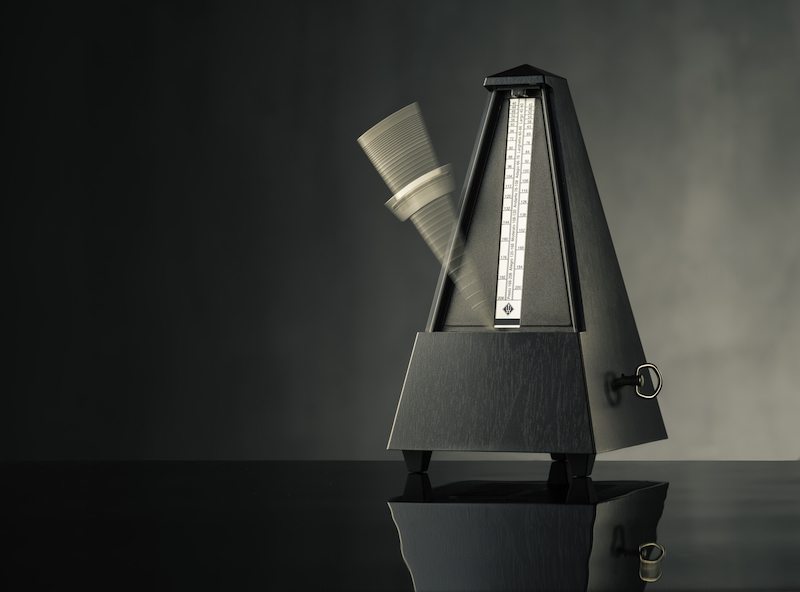Are you ready to target the bad habits that demolish your capacity to play and sing well? This is how musicians ruin their potential for mastery:
- reading notation with lazy, shortcut-ridden methods
- memorizing too soon
- performing music with imperfectly constructed muscle memory
Problems 1 and 2 conspire to construct Problem 3, which is the annihilator of good music and the guarantor of false starts, fumbled notes, and flawed sounds. Let’s explore tactics for identifying, eliminating, and replacing them.
A wilderness of wasted potential and unrealized goals awaits any musician that ignores these destroyers of mastery. If you can abolish them from your practice habits, then you may emerge from that wilderness and realize your musical ambitions.
Solving the Riddle of Notation and Memory
When confronted with the reality of what the human brain is supposed to do with notation, many musicians begin searching for shortcuts, hacks, and other methods for outmaneuvering the ink and paper.
Some write in the note names, some learn the music by ear, some use the lyrics to cue memory. Indeed, some musicians attempt everything but actually reading the music. And when they do “read” the music, they are usually just deciphering it for immediate conversion into memory.
Memories formulated in this way are typically riddled with error.
Here’s how the folly goes down:
- first, a malfunctioning musician deciphers a short segment of music using a semi-literate method
- next, he or she converts the segment into rote memory through relentless repetition
- last, he or she abandons the segment’s notation forever.
You’ll know if you are misbehaving in this way if you find yourself having to continually back up in the music to make a successful run at any given passage. For example, if you need to start again at the beginning of a song to successfully play measure five, then you are likely making this mistake.
Breaking the Habit
Practicing in this way is music-destroying nonsense. You should not have to handle difficult passages like a musical long jumper.
To break this habit, you must learn how to read properly, which is done by establishing a consistent problem-solving operation. You can set up such a problem-solving operation by asking – and finding the answers to – the following questions:
- What clef am I reading?
- Is the note on a line, space, or ledger line?
- What is the note’s name?
- Where is the note on my instrument?
- How do I execute the note?
- How long should the note last?
- What note comes next?
Go over a passage of music several times with this question-and-answer process. Before long, you will begin to make sense of the music’s details.
Count Your Way to Mastery
Once you are feeling clear and confident about these details, the next step is to count out loud as you play. (Count in your mind, or tap your foot, if you are a singer or have an instrument in your mouth.)
While counting and playing, you will confront uncertainty born of difficult passages. The right course of action, upon encountering these uncertainties, is to pause, clarify, and proceed. This means that you should stop making sound, review the tricky passage, and pick up counting and playing where you left off.
The Best Way to Memorize
If you count and play through the music several times, then you will soon eliminate the need to pause and clarify. You will also begin constructing clear memories. Once you are feeling confident about your memory, you can test it with visualization, which is a method for seeing clearly in the mind’s eye that which was previously visible on the page or instrument.
This is how you visualize: Hold your hands in a position such that you are pretending to play your instrument, form a clear mental picture of the music, say the note names out loud, and move your fingers like you are playing each note.
This should be done without looking at the music or playing your instrument. The music should exist wholly within your mind. Once you can visualize the music in this way, you can be reasonably certain that you possess clear and accurate memories of the material.
Practicing like this will foster body movements that escape the gaze of conscious thought. This is called muscle memory. It’s a kind of automaticity that is achieved through continued practice. When you have formed deep, intractable muscle memories, the music is ready for performance.
The Determinism of Performance
The experience of performing music is a curious state in which you, as the performer, are in some sense a witness to your own performance. Indeed, the process seems to consist solely of the repeated deployment of muscle-memory phrases that unfurl under their own direction. You, as the performer, operate as a sort of conductor who is choosing which phrases unfurl and when they do so.
Mind to Body
To manage this process, you must assemble a coherent train of thought designed to wrangle your intentions into actions. In concrete terms, this means that you must assemble your thoughts around where your body is at any given moment, where it is going in the next moment, and how to guide it there willfully.
Once you are operating in this way, you can lean into your performance to deliver it with confidence and power. Here’s how:
- Visualize the opening passage with complete and total awareness of tempo, note content, and articulation
- Direct your body to execute the first passage with explicit intention
- Prepare your mind and body for impending passages
- See clearly in your mind’s eye the locus of those future notes
- Guide your body to the next passage with unambiguous volition
Repeat these steps of anticipation, preparation, and execution until the song is done. Remember to have fun and to be nice to your audience.
How to Handle Mistakes
If you make a mistake, do not, under any circumstance, advertise that you did so. Do not raise an eyebrow, do not grimace, do not move about spastically, and do not look cross-eyed at your band mates. Instead, just keep smiling and attempt to make the mistake part of the performance–perhaps by repeating some variation of the error.
Nobody will know, and life will go on.
If you have read your music carefully and prepared your muscle memory wisely, then performing should be pleasant. Why shouldn’t it be? After all, you have become a perfect transmitter of the organized sound we call “music”, which other human beings find so compelling.
The System of Mastery
Here’s a quick cheat-sheet on the proper ways to read, memorize, and perform music:
The proper way to read notation is to
- identify a note’s letter name and physical location
- articulate the note with full awareness of detail, and
- place the note in time by counting out loud.
The proper way to memorize music is to
- read carefully and deliberately,
- isolate short, manageable segments for memorization, and
- use visualization to test your memory.
The proper way to perform music is to
- command the present moment and direct all impending moments,
- visualize the destination of approaching notes, and
- deploy muscle memory in a reasoned order.
When you put your deliberate will into your musical habits, your efforts will be rewarded with masterful performance – satisfying both you and your audience. Read, memorize, and perform music using these guidelines and you will destroy the destroyers of mastery.











